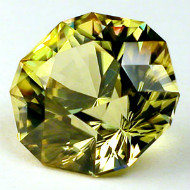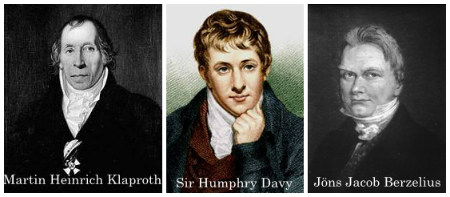- Zirconium: element discovery
 Zirconium is named for the mineral zircon, which has been used as a jewel for centuries. The earliest known minerals included jargon, jacinth and hyacinth, which are all forms of zircon, whose chemical name is zirconium silicate (ZrSiO4). Zircons are mentioned in the Bible. They were one of the twelve gems worn by the high priests of Israel. The crystals of zircon come in many colors including green, blue, orange, red and gold. A Hindu legend describes an offering made to an ancient god in the form of a jewel-encrusted tree with green zircon leaves. Sometimes appearing as colorless stones they have a brilliant sparkle when they are cut. For this reason, the stones were thought for a long time to be a soft type of diamond. In the Middle Ages, many people believed zircon aided sleep, promoted riches and wisdom, and warded off evil spirits.
Zirconium is named for the mineral zircon, which has been used as a jewel for centuries. The earliest known minerals included jargon, jacinth and hyacinth, which are all forms of zircon, whose chemical name is zirconium silicate (ZrSiO4). Zircons are mentioned in the Bible. They were one of the twelve gems worn by the high priests of Israel. The crystals of zircon come in many colors including green, blue, orange, red and gold. A Hindu legend describes an offering made to an ancient god in the form of a jewel-encrusted tree with green zircon leaves. Sometimes appearing as colorless stones they have a brilliant sparkle when they are cut. For this reason, the stones were thought for a long time to be a soft type of diamond. In the Middle Ages, many people believed zircon aided sleep, promoted riches and wisdom, and warded off evil spirits.- These are zircon crystals as they appear when found in the Earth’s crust:

- German chemist Martin Heinrich Klaproth (1743-1817) discovered the element zirconium in 1789. He made the discovery while studying a sample of zircon from Ceylon, today called Sri Lanka. Although many chemists of the time thought it was a form of alumina, Klaproth suspected that the mineral contained a new element. He was able to extract zirconium dioxide from zircon, but he was unable to remove oxygen from the substance. Still, he recognized that he had discovered a new element.

- Klaproth first named the new element Zirkonerde (zircon earth, or zirconia). English chemist Sir Humphry Davy (1778-1829) suggested the name zirconium in the early 1800s.
- Klaproth was unable to produce pure zirconium. It was 35 years later, in 1824, that the Swedish chemist Jöns Jacob Berzelius (1779-1848) —a rival of Klaproth — first made a sample of pure zirconium metal. Several other chemists had been trying to do this. Berzelius succeeded by heating a mixture of potassium and potassium zirconium fluoride in an iron tube. He obtained a black powder that was 93 percent zirconium, but he could not purify it further. It was not until almost one hundred years later that high-purity zirconium could be made. This delayed progress in studying the element.
- The element zirconium is named after the mineral in which it was discovered, zircon. The word “zircon” was probably derived from the Persian word zargun, which means “golden-colored.” Some zircon crystals have a gold color.
-
About us
Contact us
Make a suggestion
- Metalpedia is a non-profit website, aiming to broaden metal knowledge and provide extensive reference database to users. It provides users reliable information and knowledge to the greatest extent. If there is any copyright violation, please notify us through our contact details to delete such infringement content promptly.
 Zirconium is named for the mineral zircon, which has been used as a jewel for centuries. The earliest known minerals included jargon, jacinth and hyacinth, which are all forms of zircon, whose chemical name is zirconium silicate (ZrSiO4). Zircons are mentioned in the Bible. They were one of the twelve gems worn by the high priests of Israel. The crystals of zircon come in many colors including green, blue, orange, red and gold. A Hindu legend describes an offering made to an ancient god in the form of a jewel-encrusted tree with green zircon leaves. Sometimes appearing as colorless stones they have a brilliant sparkle when they are cut. For this reason, the stones were thought for a long time to be a soft type of diamond. In the Middle Ages, many people believed zircon aided sleep, promoted riches and wisdom, and warded off evil spirits.
Zirconium is named for the mineral zircon, which has been used as a jewel for centuries. The earliest known minerals included jargon, jacinth and hyacinth, which are all forms of zircon, whose chemical name is zirconium silicate (ZrSiO4). Zircons are mentioned in the Bible. They were one of the twelve gems worn by the high priests of Israel. The crystals of zircon come in many colors including green, blue, orange, red and gold. A Hindu legend describes an offering made to an ancient god in the form of a jewel-encrusted tree with green zircon leaves. Sometimes appearing as colorless stones they have a brilliant sparkle when they are cut. For this reason, the stones were thought for a long time to be a soft type of diamond. In the Middle Ages, many people believed zircon aided sleep, promoted riches and wisdom, and warded off evil spirits.

